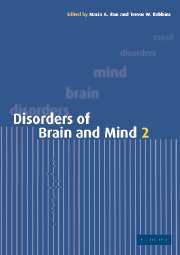Book contents
- Frontmatter
- Contents
- List of contributors
- Preface
- Part I Genes and behaviour
- Part II Brain development
- Part III New ways of imaging the brain
- Part VI Imaging the normal and abnormal mind
- Part V Consciousness and will
- Part IV Recent advances in dementia
- Part VII Affective illness
- 14 The neuropathology of mood disorders
- 15 The neural substrates of anxiety
- 16 Social separation models of depression
- Part VIII Aggression
- Part IX Drug use and abuse
- Index
- Plate section
- References
16 - Social separation models of depression
from Part VII - Affective illness
Published online by Cambridge University Press: 19 January 2010
- Frontmatter
- Contents
- List of contributors
- Preface
- Part I Genes and behaviour
- Part II Brain development
- Part III New ways of imaging the brain
- Part VI Imaging the normal and abnormal mind
- Part V Consciousness and will
- Part IV Recent advances in dementia
- Part VII Affective illness
- 14 The neuropathology of mood disorders
- 15 The neural substrates of anxiety
- 16 Social separation models of depression
- Part VIII Aggression
- Part IX Drug use and abuse
- Index
- Plate section
- References
Summary
Introduction
The clinical presentations that attract the label ‘depression’ represent a major public health concern because of their high prevalence, stigma, morbidity and mortality. Despite best efforts, research has, thus far, failed to illuminate a plausible pathophysiology of depression, to explain why some individuals are more at risk than others or to explain the efficacy of available treatments. Modelling pathophysiological states in experimental animals has proven an effective strategy in improving our understanding of many other major medical conditions and has led to the development of better treatments. In this chapter, I shall review a range of work with experimental animals that may contribute to our eventual understanding of some aspects of depression. This review focuses on the manipulation of social environment as a means of perturbing physiology and behaviour and attempts to relate findings from animal studies to core clinical concepts.
What is depression?
Depression is a common, complex and poorly understood condition. Perhaps because the same word is used to describe the brief periods of unhappiness and disappointment that everyone experiences in response to minor life upsets, there is a popular view that depression is a relatively trivial and self-limiting problem. The reality is very different.
It (depression) was the worst experience of my life. More terrible even than watching my wife die of cancer … I was in a state that bears no resemblance to anything I had experienced before, I was not just feeling low … I was seriously ill.
(Wolpert 1999)I was feeling in my mind a sensation close to, but indescribably different from pain … for myself, the pain is most closely connected to drowning or suffocation — but even these images are off the mark.
(Styron 1992)- Type
- Chapter
- Information
- Disorders of Brain and Mind , pp. 338 - 372Publisher: Cambridge University PressPrint publication year: 2003



